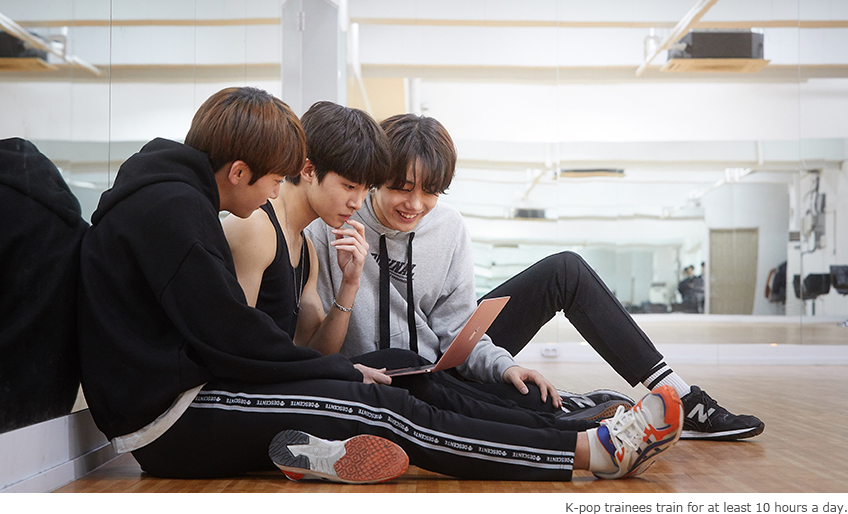

K-pop today,
K-pop tomorrow
Last year, the 2017 American Music Awards were held in Los Angeles. he pop sensation BTS became the first Korean pop group to perform at the awards ceremony, which, along with the Grammys, is considered as one of the biggest music awards shows in the U.S. The seven-member group BTS gave a great live performance, featuring songs off its new single “DNA,” and the audience loved it. Previously regarded as part of a distant land far away, Korean pop music has now gained a presence in the very birthplace of pop music. Meanwhile, the Korean group Twice performed at NHK’s Kohaku Uta Gassen. The last appearance of a K-pop artist at the year-end music festival in Japan was in 2011, when the lineup featured TVXQ, Kara, and Girls’ Generation. This surge in popularity for Korean pop, which was thought to have died down in Japan, has returned stronger than ever.
Written by Ahn Min-joo, Broadcasting writer Photographed by Studio Kenn

Striking a chord

Power of social media
In 2012, Psy’s global sensation “Gangnam Style” went viral on YouTube. There’s no denying that YouTube helped to created the “Gangnam Style” wave. Now, more than ever, social media and similar video-sharing platforms are actively used as tools for marketing and branding.
In November 2017, BTS reached 10 million followers on Twitter, a first in Korea, and was also named the most re-tweeted artist of the year. The pop group not only released mix tapes and cover songs, but also posted self-produced videos two to three times a week, allowing the group to interact with its followers. What made the group a global Twitter star was its efforts to tweet in their fans’ languages, so as to reach out to as many people as possible all around the world.
Ranked first in a Billboard list of Top-5 New K-Pop Artists to Watch in 2018, Stray Kids is a relatively new group on the scene. Although the groups hasn’t made its official debut yet, the boy band has managed to garner a lot of attention by releasing its pre-debut album “Mixtape.” The members wrote the songs and the choreography, and relied on social media to pitch themselves to their fans. The group is an exemplary case for the Korean pop music industry in an age of digital and mobile consumption.


Rigorous training
In the song “Glow,” the group Stray Kids talks about the challenges and confusion experienced as trainees, and how much they look forward to their official debut. As shown in the lyrics, fame and glory don’t come overnight for pop singers.
Korean talent agencies have a system of auditions that they use to recruit trainees who have potential to become stars. The three major agencies are SM, YG and JYP.
They pick only one or two trainees out of tens of thousands of applicants. The artist Key, a member of the Korean boy group Shinee, was recruited by SM Entertainment from among 8,000 other applicants for the same position. Even after passing the initial audition, trainees undergo rigorous training programs and are assessed at the end of each month. The training period can last from several years to more than a decade. It was 6.5 years for Exo’s member Suho, 10 years for Twice’s Jihyo, and seven years for Red Velvet’s Seulgi. They are carefully evaluated based on singing, dancing, acting and linguistic proficiency. In such a cut throat environment, most applicants spend at least 17 to 18 hours a day honing their skills.
Once they make their debuts, the artists are micromanaged by their agencies. Most live in dormitories. This allows for more control, but also strengthens the sense of teamwork, and saves time during busy daily schedules. Sharing their personal lives on social media is how they become more intimate with their fans, but it also means having less time for themselves. The phenomenal success of a few Korean pop stars has, in many ways, overshadowed their hard work and determination.

Audition, audition, audition
Live audition talent shows, such as “Produce 101,” “Mix Nine” and “The Unit,” have grown increasingly popular on Korean TV. The programs feature a diverse range of talent, from fresh trainees to current pop stars who have failed to enjoy lucrative careers. The most successful group to appear on such a show is Wanna One, the winning team of a recent season of “Produce 101.” Wanna One has now set new milestones for other groups, with its first concert garnering more than 20,000 fans and its debut album selling more than one million copies.
Instead of talent agencies, viewers themselves, the so-called “national producers,” had the final say in determining the debut of Wanna One. TV viewers and fans voted for their favorite trainees and encouraged others to do the same, as though launching an election campaign. Many fans feel a strong sense of loyalty from having watched their would-be stars grow from week to week, and it’s no wonder that the group topped the charts from the moment of its debut.

Live audition TV shows that capture the journey of growth are universally touching. This helps to build a solid fan base, regardless of age, sex or nationality. Other talent agencies have followed suit, encouraging more fans to get involved in choosing members of a new potential pop group or who should release a new single.
The wave of Korean pop music that we’ve seen across East Asia and elsewhere is continuing to grow. Billboard will be focusing on Korea as the main content generator in the broader Asian market, and plans to expand across the region with the establishment of Billboard Korea. This is an acknowledgment of the vast influence that talented Korean artists and tightly run talent agencies are having on the world of pop music.
The convergence of cultures, the use of social media, and efforts to globalize Korean pop music have all aided in the development of today’s Korean pop music industry. Today, the K-pop music syndrome continues to be strong.
* The article is based on the opinions of pop music critics.
Program Information

-
Produce 101 Season 2
The second season of Produce 101, a boy group survival reality show.
Only 11 members are selected among 101 trainees from various
entertainment companies.

-
Mix Nine
A survival reality show judged by Yang Hyun-suk, the founder of YG
Entertainment. The show stands apart from other similar programs in
that Yang travels around Korea to choose trainees in person.

-
The Unit
A survival reality show that gives a second opportunity to lesser-
known Korean idols who have already debuted. Singer and actor Rain
serves as one of the show’s mentors.
Other Articles


K-pop tomorrow

Sharing the Spotlight

Where Past Meets Present

para ice hockey player

well-designed things

Smart Technology, Services

Korea’s Take on Chicken


in Hong Kong
Application of subscription
Sign upThe event winners
Go


 March 2018
March 2018




